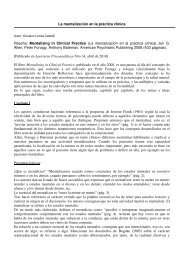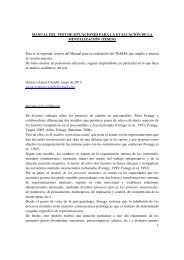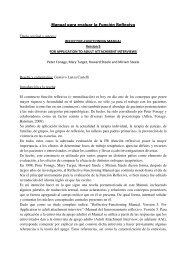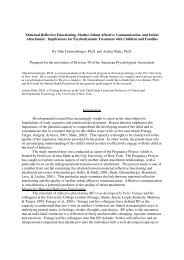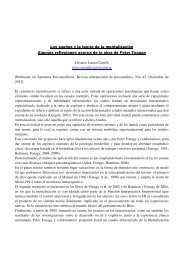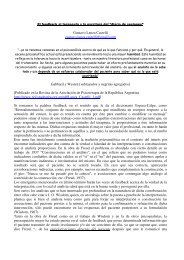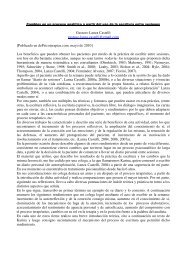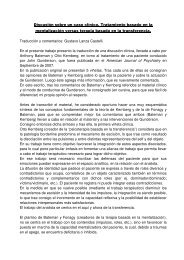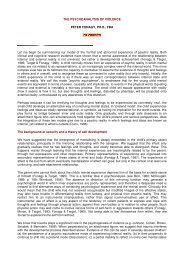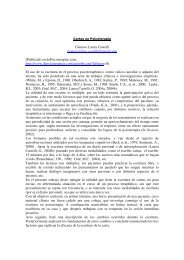Mentalization, Mental States and Affect Elaboration - mentalizacion y ...
Mentalization, Mental States and Affect Elaboration - mentalizacion y ...
Mentalization, Mental States and Affect Elaboration - mentalizacion y ...
Create successful ePaper yourself
Turn your PDF publications into a flip-book with our unique Google optimized e-Paper software.
1. Some clearly identifiable security seeking process is activated that is <strong>and</strong><br />
remains outside of the subject’s immediate awareness : free expression of<br />
wish, vs superego sanctioned opposition. This is a repetition without<br />
remembering. Wish-defense or expansion-contraction (Gray’s) model of<br />
conflict as firmly established within the intrapsychic sphere, is presently<br />
active <strong>and</strong> documented in the material.<br />
2. It is possible to clearly identify in the material one or more of the following<br />
[repression, neurotic projection, introjection, reaction formation,<br />
displacement, negation, intellectualization, isolation, undoing] that currently<br />
block, inhibit, distort or transform the expression of wishes or affects or a<br />
reflective process.<br />
3. Defensively charged emotions <strong>and</strong> expressions are verbally expressed<br />
(anxiety, fear, inhibitions, guilt, laughs, sarcasm). Wish related affects are<br />
toned-down. Manifest (verbally expressed) defensive affects (or modes of<br />
relating) cover another mode or affect, which is inhibited, repressed,<br />
projected, i.e. transformed by a higher-level defense. Subject contains <strong>and</strong><br />
transforms motivational pressures.<br />
4. Material contains some aspect that make it possible to infer what is being<br />
defended against.<br />
5. Objective or subjective observation of self or other is in the service of<br />
security, self-protection <strong>and</strong>/or resistance, within a wish-defense conflict.<br />
6. Aggression against self (i.e. contraction movement) is organized around guilt<br />
<strong>and</strong> associated feelings.<br />
Intermediate-level defensive mental activity<br />
1. Some clearly identifiable security seeking process is activated that is <strong>and</strong><br />
remains outside of the subject’s immediate awareness. This is a repetition<br />
without remembering. The conflict concerns the mental recognition of the<br />
existence or not of a damaging piece of reality to the self or others (trauma,<br />
abuse, self-destructive tendencies, damage to loved ones). This dilemma is<br />
firmly established within the intrapsychic sphere, is presently active <strong>and</strong><br />
documented in the material.<br />
2. It is possible to clearly identify in the material one or more of the following<br />
[denial, minimization or disavowal] where a piece of perception or a part of<br />
the mind is obliterated, or a downplaying of the personal meaning of a<br />
recognized, accurately perceived event, occurs. This currently blocks, inhibits,<br />
distorts or transform the expression of wishes or affects or a reflective process.<br />
3. Emotional expression is consequently dampened. Wish related affects are<br />
toned-down. The self’s (or object’s) subjective truth (as damaged) is not<br />
acknowledged. If present (verbally expressed) defensive affects (or modes of<br />
relating) cover another mode or affect, which is denied or minimized. Subject<br />
contains <strong>and</strong> transforms motivational pressures, with the possible exception of<br />
non-verbal affective expressions (i.e. laugh, sarcasm).<br />
4. Material contains some aspect that make it possible to infer what is being<br />
defended against.



